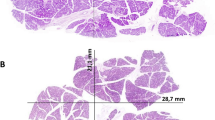Abstract
Ultrastructural features and cytokeratin expression of inverted ductal papillomas of minor salivary gland origin were studied. Under the electron microscope, an increased number of desmosomes and mucus-like granules in some cells were the most striking features. Immuno-histochemical study revealed that tumor cells displayed strongly positive reactions with cytokeratins 13 and 14, and less strong reactions with cytokeratins 7, 8, 18 and 5D3. These results support the hypothesis that an inverted ductal papilloma can be derived from the proximal portion of a salivary gland excretory duct.
Similar content being viewed by others
References
Alroy J, Miller AW, Coon IS, James KK, Gould VE (1980) Inverted papillorna of the urinary bladder. Ultrastructural and immunologic studies. Cancer 46:64–70
Born IA, Schwechheimer K, Maier H, Otto HF (1987) Cytokeratin expression in normal salivary glands and in cystadenolymphomas demonstrated by monoclonal antibodies against selective cytokeratin polypeptides. Virchows Arch [A] 411: 583–589
Christensen WN, Smith RR (1986) Schneiderian papillomas: a clinicopathologic study of 67 cases. Hum Pathol 17:3393–3400
Ellis GL, Auclair PL (1991) Ductal papillomas. In: Ellis GL, Auclair PL, Gnepp DR (eds) Surgical pathology of the salivary glands. Saunders, Philadelphia, pp 244–247
Gerdes J, Becker MHG, Key G, Cattoret G (1992) Immunohistological detection of tumor growth fraction (Ki-67 antigen) in formalin-fixed and routinely processed tissues. J Pathol 168: 85–87
Hyams VJ (1971) Papillomas of the nasal cavity and paranasal sinuses: a clinicopathological study of 315 cases. Ann Otolaryngol 80:192–206
Moll R, Franke WW, Schiller DL, Geiger B, Krepler R (1982) The catalog of human cytokeratins: patterns of expression in normal epithelia, tumors and cultured cells. Cell 31:11–24
Regezi JA, Lloyd RV, Zarbo RJ, McClatchey KD (1985) Minor salivary gland tumors: a histologic and immunohistochemical study. Cancer 55:108–115
Seifert G, Brocheriou C, Cardesa A, Eveson JW (1990) WHO international histologic classification of tumours. Tentative histological classification of salivary gland tumours. Pathol Res Pract 186:555–581
Shi SR, Key ME, Kalra KL (1991) Antigen retrieval in formalin-fixed, paraffin-embedded tissues: an enhancement method for immunohistochemical staining based on microwave oven heating of tissue sections. J Histochem Cytochem 39:741–748
White OK, Miller AS, MacDaniel RK, Rothman BN (1982) Inverted ductal papilloma: a distinctive lesion of minor salivary gland. Cancer 49:519–524
Wilson DF, Robinson BW (1984) Oral inverted ductal papilloma. Oral Surg 57:520–523
Author information
Authors and Affiliations
Rights and permissions
About this article
Cite this article
Machado de Sousa, S.O., Sesso, A., Soares de Araújo, N. et al. Inverted ductal papilloma of minor salivary gland origin: morphological aspects and cytokeratin expression. Eur Arch Otorhinolaryngol 252, 370–373 (1995). https://doi.org/10.1007/BF00178280
Received:
Accepted:
Issue Date:
DOI: https://doi.org/10.1007/BF00178280




